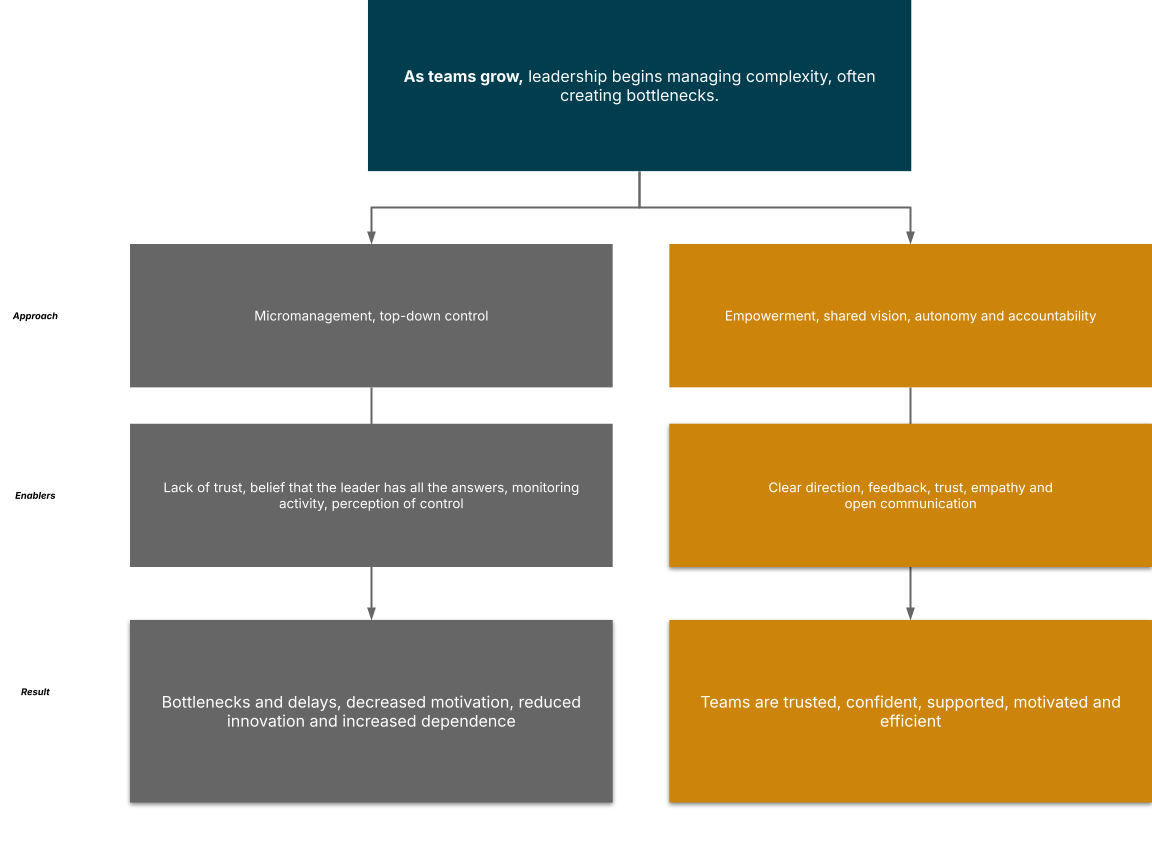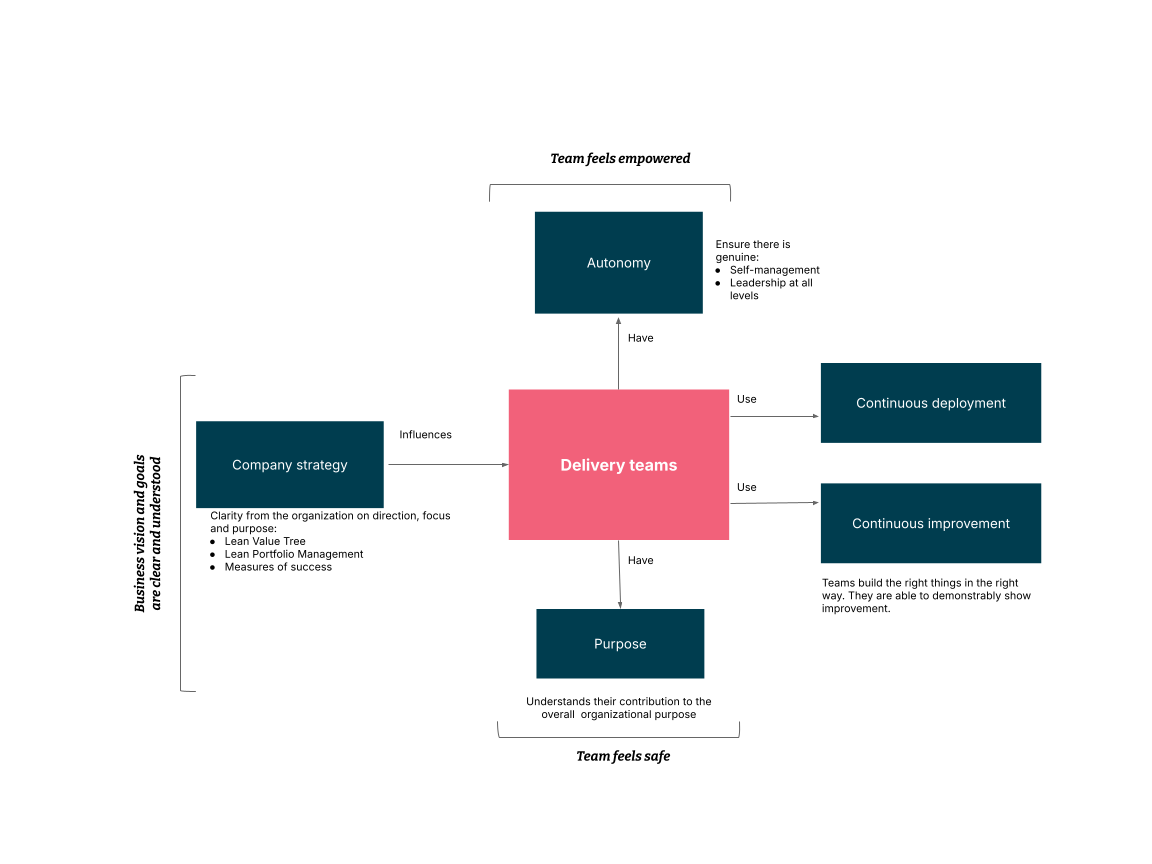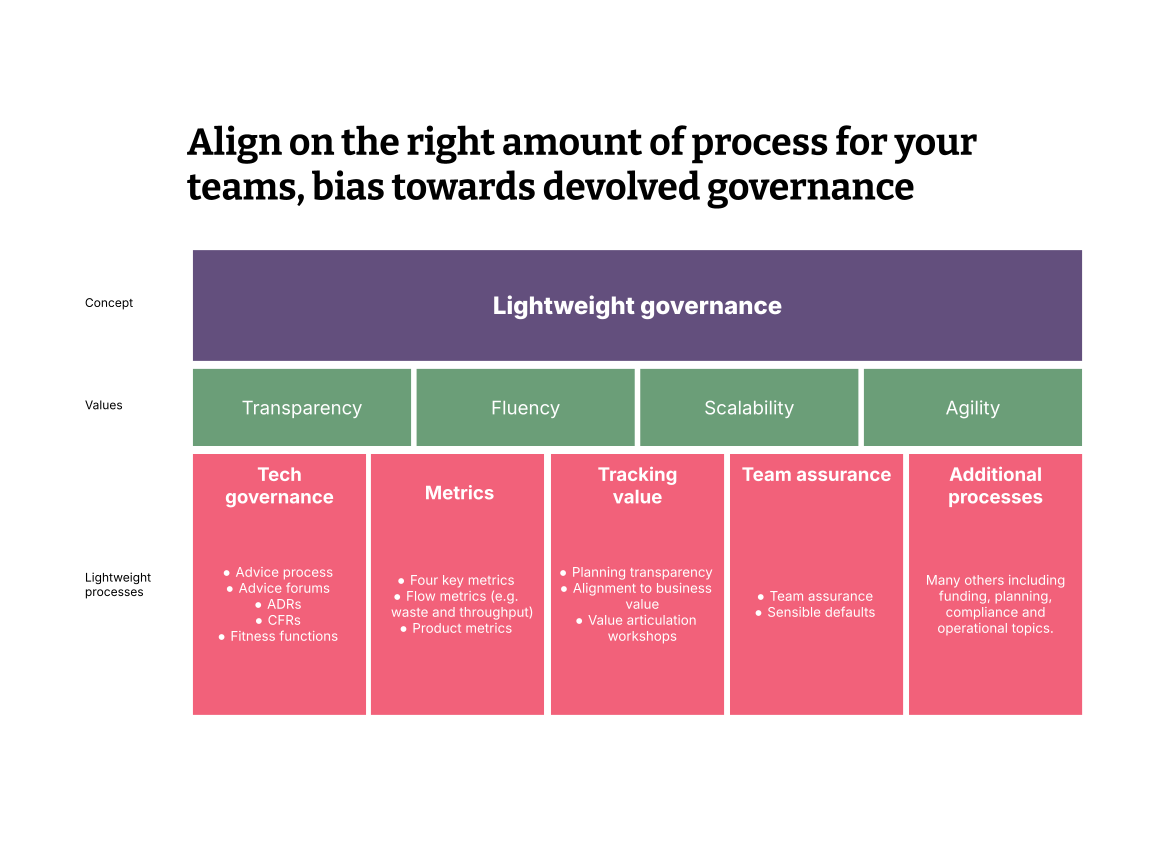As teams grow, both in size and number, leadership often shifts from enabling progress to managing complexity. How do you lead without becoming a bottleneck?
If there's one thing I've learned from years of leading teams through complex software deliveries, it's that leadership isn't about micromanagement or top-down control. It's about something much more valuable — and, frankly, more rewarding. You need to let go of control, help teams align to a vision and be independent in order to be able to scale your leadership.


I'm a strong believer that the best results come from empowered teams that have a shared understanding of the vision and operate independently. In other words, they take accountability for achieving the right thing. It’s enabled by fostering that shared understanding, providing consistent feedback, equipping them with the necessary resources and trusting in their ability to deliver. Challenges are inevitable, but empathy, open communication and even a bit of well-placed humour can make all the difference.
For instance, in my experience, teams that lack accountability often struggle with predictability. They may provide inaccurate estimates or conceal risks, potentially due to a fear of speaking up. This contrasts with teams that demonstrate strong accountability by communicating risks transparently and proactively, which allows for better planning and decision-making.
This is a sensible and practical approach that works. To position it another way, why would it make sense to load your teams with bureaucracy or for them to have to unnecessarily wait for decisions to be made? It's about fostering an environment where people are trusted, feel confident, supported and motivated to do their best work — it’s a place where they’re encouraged to solve problems directly and efficiently.
In this post I’ll share what actually worked for me to lead at scale — and what leading at scale actually means.
The common pitfalls of scaling leadership
When you find yourself accountable for outcomes spanning multiple teams it’s human nature and fairly common to fall into some or all of the following traps, especially when you yourself are under pressure:
Over-reliance on command-and-control. Micromanagement seldom works for creative problem solving/knowledge work and it certainly fails spectacularly at scale. There aren’t enough hours in the day or the mental capacity to achieve anything meaningful through micromanagement. This should be obvious, but if you’re spending more time managing people, you’re not focused on the value you can bring to the organization — looking ahead and sensing other potential challenges or identifying new opportunities.
The illusion of control. Excessive reporting, multiple or process-heavy governance, top-down decision-making will only slow teams down. Even worse, teams spend more time preparing status reports or vanity updates than delivering the value that will secure or deliver new revenue for the organization. Focus instead on the leading indicators as a predictive measure of future performance — queue depth/bottlenecks and the economics, how many people, how long?
Silos and misalignment. When leadership is poorly structured, it creates discontentment and increases distance from the customer or stakeholders. A common symptom is the formation of new, localized reporting structures, which disconnect teams from leadership and delay responses, ultimately reducing system flexibility.
In these situations, it's crucial to remember Jurgen Appelo's advice from Management 3.0: 'Manage the system, not the people.' This principle serves as a valuable check to avoid counterproductive interventions.
The chaos to empowerment
No matter how well you prepare, there will always be a period of chaos, especially when you’re applying different leadership techniques to what your teams have been used to.
Many teams will have years of experience in taking instruction or passing off problems to people more “senior” than themselves — they’re stuck in the corporate antipattern of “it’s above my pay grade”. In order to scale leadership you need to create an environment for them to succeed, so that EVERY team member can drive with minimal, or rather a leaner set of guardrails. We want teams to be encouraged to decide for themselves safely and efficiently in line with the vision. Just be prepared for the unique and innovative directions this may take you.
This doesn’t mean your role is redundant, although it might be good to think about making any old ways of working you held on to as redundant! If your team struggles with operating independently and you want to empower them, it’s a good idea to first look at your leadership style.
Key principles for leadership at scale
The following principles will help guide and shape how you scale leadership:
| Principle | Description | Example |
Employ adaptive leadership techniques |
How you guide rather than dictate. |
Instead of telling a team how to implement a feature, facilitate a workshop for them to explore different technical approaches and choose the best one. |
| Build trust | New communication routines that incorporate the whole team; consider also that they will need psychological safety to thrive. |
Establish regular open discussions in a retrospective style where teams can openly discuss what's working and what's not, fostering a safe environment for feedback. |
| Share context and set direction | Think about how you articulate strategy and outcomes while giving teams the autonomy to decide how to achieve them. |
Clearly communicate the product vision and key performance indicators, leave the teams to define their own roadmap and processes. |
| Decentralize decision-making | Empower teams to make local decisions and refine and validate through lightweight governance. |
Allow teams to choose their preferred technologies while ensuring alignment with overall architectural principles through regular technical design reviews. |
| Focus on outcomes, not outputs | Measure success by value delivered rather than tasks completed. | Shift from tracking the number of features delivered to measuring the impact of those features on customer satisfaction or business metrics.
The biggest waste with traditional leadership is tracking the work done, this tells you everything and nothing and instils legacy behavior. |
| Enable alignment across teams | For scaled leadership to be successful, it needs to apply to all of your teams. Simple practices like cross-team stand-ups and advice forums keep teams working towards shared goals without excessive process. | Implement regular cross-team stand-ups to coordinate efforts, share learnings and identify dependencies between teams. |
| Delegation not abdication | You want to set the teams up for success rather than leaving them to struggle. | When delegating, provide the team with the necessary resources and support and offer guidance without taking over. |
Practical strategies for scaling leadership
It's important to acknowledge that change can be uncomfortable, so preparation is crucial, but don't wait for the perfect plan — identify a small, achievable step and start implementing it today! You'll gain more valuable insights from experimenting with different leadership approaches than from endlessly studying them in theory.
When communicating the overall goals and mission, be both confident and transparent about the challenges and uncertainties. This honesty builds trust and encourages teams to embrace the mission as their own.
Empower teams by making it clear that they have your support to:
Identify their own work.
Make their own decisions.
Proactively address challenges.
Define processes that align with their specific goals.
Delegate effectively within their own teams.


To foster a broader business perspective, guide teams toward recognizing and articulating the value of their work. When team members start thinking like business leaders, they prioritize effectively and communicate value clearly to stakeholders.
Here are some practical tools and approaches to support these strategies:
Value articulation frameworks. Implement a simple, consistent method to help teams define, measure and communicate the business value of their work. This could involve using techniques like user story mapping, impact mapping or cost-of-delay analysis to ensure that everyone understands the "why" behind their tasks.
Lightweight governance models. Establish governance processes that provide necessary visibility and guidance without introducing unnecessary bureaucracy. Focus on self-assurance mechanisms within teams and track only the metrics that truly reflect systemic progress toward desired outcomes. Examples include team-defined working agreements, regular peer reviews and outcome-focused reporting via showcase or planning ceremonies.
Leading with guardrails and coaching. Successful scaling involves leaders setting strategic context and guardrails, freeing teams to make delivery-level decisions within them. Leaders support business growth and flow, while employing coaching techniques like powerful questioning and active listening to develop their teams.


Addressing emerging leadership challenges
As you transition to these new ways of working, it's important to anticipate and address potential challenges. Common issues that may arise include:
Increased communication overhead between teams. When autonomy increases, effective communication becomes even more critical to maintain alignment.
High cognitive load on team members. Increased decision-making responsibility can lead to cognitive overload if they are not properly supported by the knowledge system.
Reinvention of solutions. Without adequate knowledge sharing, teams may duplicate efforts.
New training and development needs. Teams may require training in areas such as decision-making, facilitation and communication.
To mitigate these challenges, it's essential to regularly evaluate and adapt your team and domain structures to ensure they support the new ways of working.
Lead for scale, not control
Leading for scale is fundamentally about choosing empowerment over control. It's about building trust, fostering alignment and creating an environment where individuals and teams can thrive and deliver exceptional outcomes. This requires a significant mindset shift: from a focus on rigid processes to a focus on tangible impact, and from a management style to a leadership style. To achieve this, leaders must actively work to spot and fix misalignment early, preventing it from turning into silos and wasted effort.
However, this transition is not without its challenges. Be prepared to address increased communication overhead between teams (which requires new communication routines), the potential for higher cognitive load on team members (who are taking on more decision-making), the risk of reinvention (which highlights the need for knowledge sharing) and the need for new training and development. These challenges highlight the importance of adapting your team and domain structure to support the new ways of working. The most effective leaders are those who prioritize removing friction, enabling flow and creating the conditions for collective success.
What’s one thing you can let go of today to enable your team to move faster?
Disclaimer: The statements and opinions expressed in this article are those of the author(s) and do not necessarily reflect the positions of Thoughtworks.


















